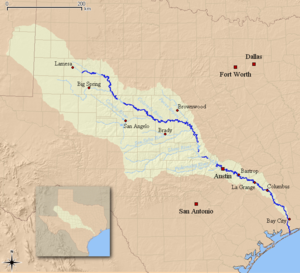Colorado River (Texas): Difference between revisions
| Line 17: | Line 17: | ||
==External links== |
==External links== |
||
=p |
|||
{{Commons|Colorado River (Texas)}} |
|||
*{{Handbook of Texas|id=CC/rnc10|name=Colorado River}} |
|||
*[http://encarta.msn.com/map_701510607/Colorado_(river_Texas).html Map of Texas's Colorado River] |
|||
*[http://www.ucratx.org/ Upper Colorado River Authority] |
|||
*[http://www.lcra.org/ Lower Colorado River Authority] |
|||
[[Category:Rivers of Texas]] |
|||
[[de:Colorado River (Texas)]] |
|||
[[fr:Colorado (fleuve du Texas)]] |
|||
[[it:Colorado (fiume - Texas)]] |
|||
[[no:Coloradoelven (Texas)]] |
|||
[[sv:Coloradofloden (Texas)]] |
|||
Revision as of 23:53, 24 September 2007


The Colorado River is the 18th longest river in the United States.[1] and the longest river with both its source and mouth within Texas; however its drainage basin and some of its usually dry tributaries do extend into New Mexico. The 862 mile long river[1] flows generally southeast from Dawson County through Marble Falls, Austin, Bastrop, Smithville, La Grange, Columbus, and Bay City before emptying into the Gulf of Mexico at Matagorda Bay.[2]
The Colorado River, which means "colored red", was frequently confused with the not too distant to the north Brazos River by early Spanish explorers.[2] It is this confusion as well as an alleged mapping error that is believed to have led to its misnaming. The river is an important source of water for farming, cities, and electrical power production. Major man-made reservoirs on the river include Lake Marble Falls, Lake Buchanan, Inks Lake, Lake LBJ, Lake Travis, Lake Austin, and Lady Bird Lake in Austin. Collectively, these lakes are known as the Highland Lakes. In addition to power plants operating on each of the major lakes, waters of the Colorado are used for cooling the South Texas Nuclear Project, near Bay City.
Flood control and use of the Colorado River is managed by two agencies established by the Texas Legislature, the Upper Colorado River Authority, and the Lower Colorado River Authority. There are 11 major reservoirs along the Colorado River.[3]
The Colorado River also has made many geographic landmarks such as Deep Eddy Pool in Austin, Texas.
LALALLA
Notes
- ^ a b Kammerer, J.C. (1987). "Largest Rivers in the United States" (HTML). United States Geological Survey. Retrieved 2006-07-15.
{{cite journal}}: Cite journal requires|journal=(help) - ^ a b Clay, Comer (1999-02-15). "Colorado River" (HTML). The Handbook of Texas Online. The General Libraries at the University of Texas at Austin and the Texas State Historical Association. Retrieved 2006-07-22.
{{cite web}}: Unknown parameter|coauthors=ignored (|author=suggested) (help) - ^ "River Basin Map of Texas" (JPEG). Bureau of Economic Geology, University of Texas at Austin. 1996. Retrieved 2006-07-15.
External links
=p
